Abstract
Malaria-infected red cells and free parasites have limited capabilities for the biosynthesis of amino acids. Therefore, the principal amino acid sources for parasite protein synthesis are the plasma free amino acids and host cell haemoglobin. Infected cells and plasmodia incorporate exogenously supplied amino acids into protein. However, the hypothesis that amino acid utilization (from an external source) is related to availability of that amino acid in haemoglobin is without universal support: it is true for isoleucine and for Plasmodium knowlesi and P. falciparum, but not for methionine, cysteine, and other amino acids, and it does not apply to P. lophurae. More by default than by direct evidence, haemoglobin is believed to be the main amino acid reservoir available to the intraerythrocytic plasmodium. Haemoglobin, ingested via the cytostome, is held in food vacuoles where auto-oxidation takes place. As a consequence, haem is released and accumulates in the vacuole as particulate haemozoin (= malaria pigment). Current evidence favours the view that haemozoin is mainly haematin. Acid and alkaline proteases (identified in crude extracts from mammalian and avian malarias) are presumably secreted directly into the food vacuole. They then digest the denatured globin and the resulting amino acids are incorporated into parasite protein. Cell-free protein synthesizing systems have been developed using P. knowlesi and P. lophurae ribosomes. In the main these systems are typically eukaryotic.
Studies of amino acid metabolism are exceedingly limited. Arginine, lysine, methionine, and proline are incorporated into protein, whereas glutamic acid is metabolized via an NADP-specific glutamic dehydrogenase. Glutamate oxidation generates NADPH and auxiliary energy (in the form of α-ketoglutarate). The role of red cell glutathione in the economy of the parasite remains obscure. Important goals for future research should be: quantitative assessment of the relative importance of amino acid sources for parasite protein synthesis; purification and characterization of plasmodial proteinases; and in vitro translation of parasite messenger RNA.
Full text
PDF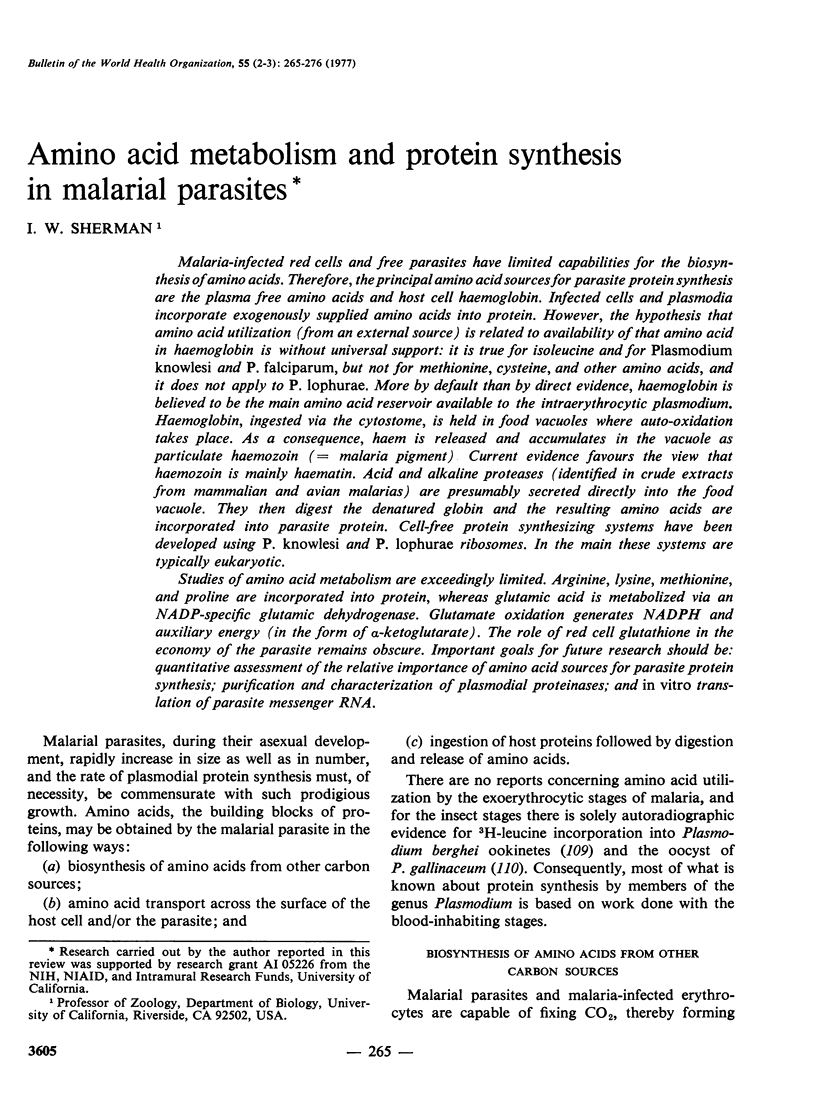
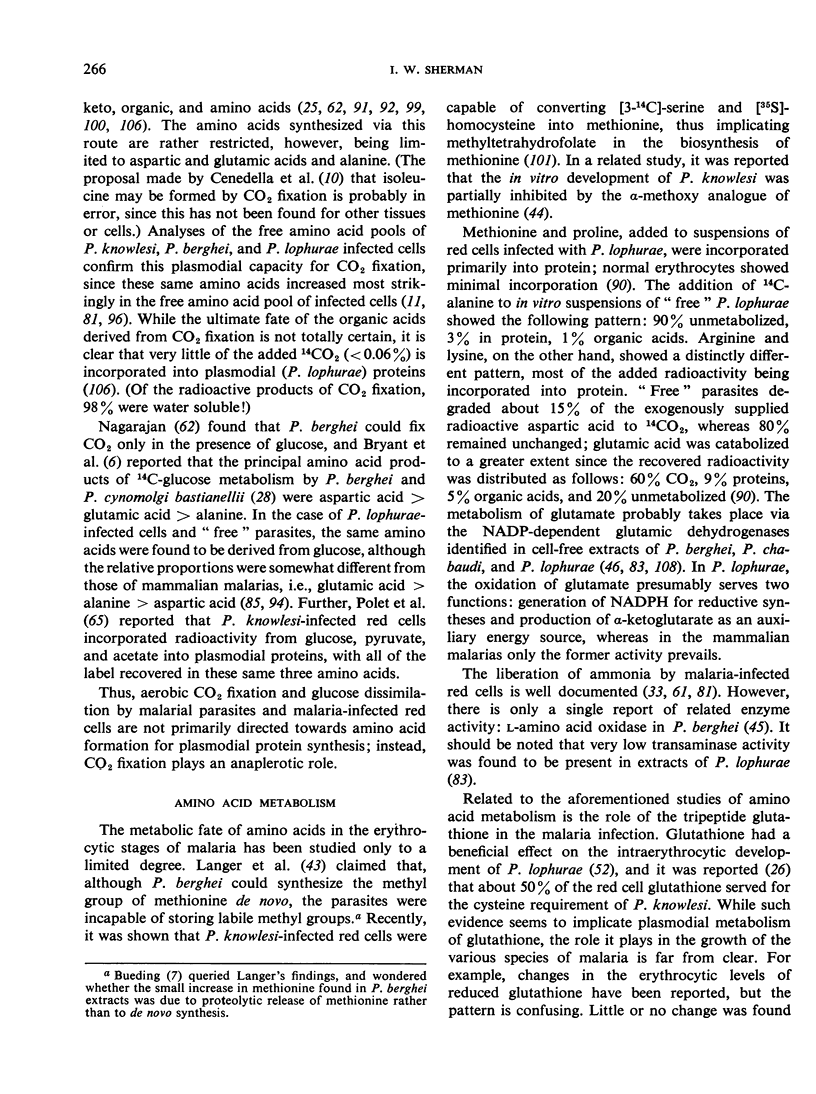
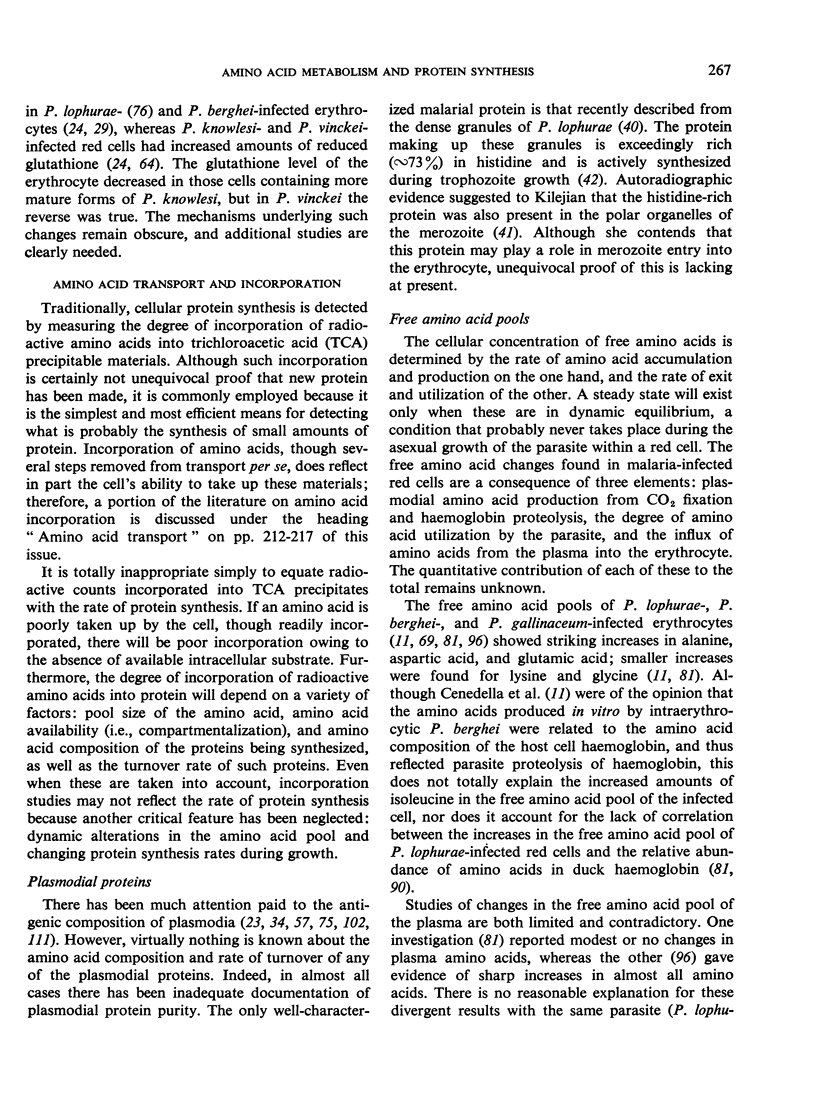
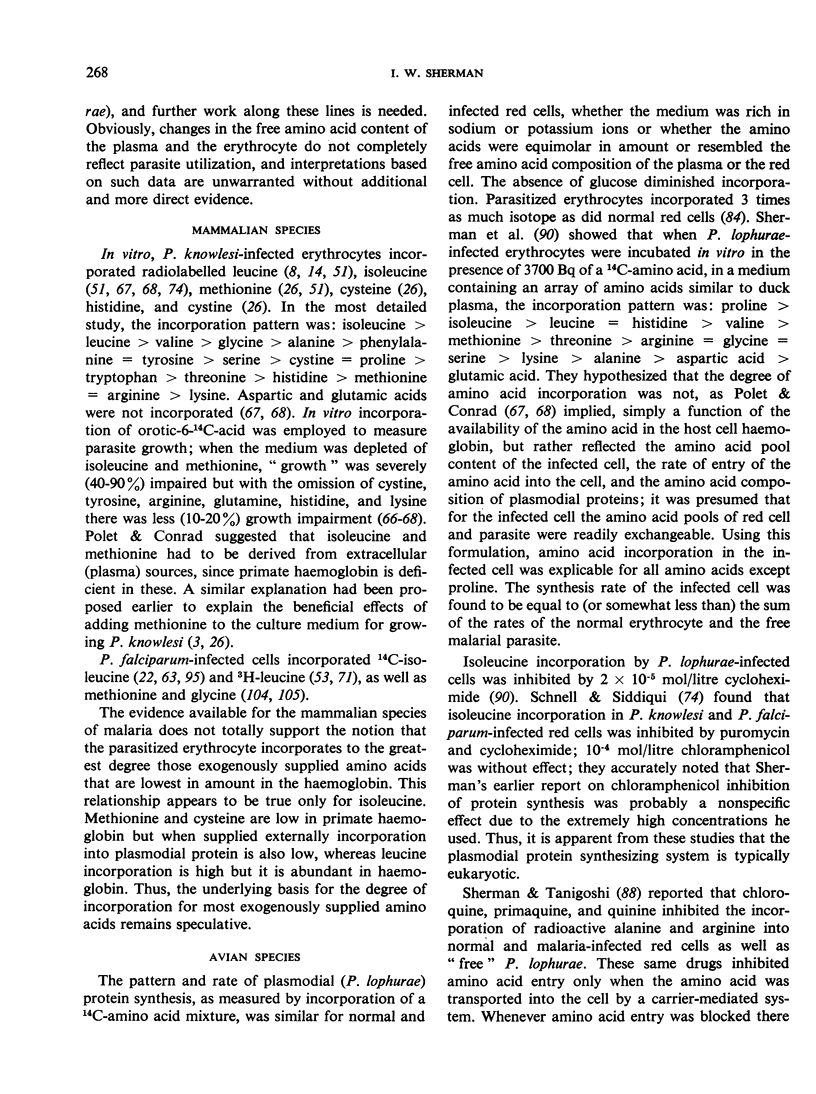
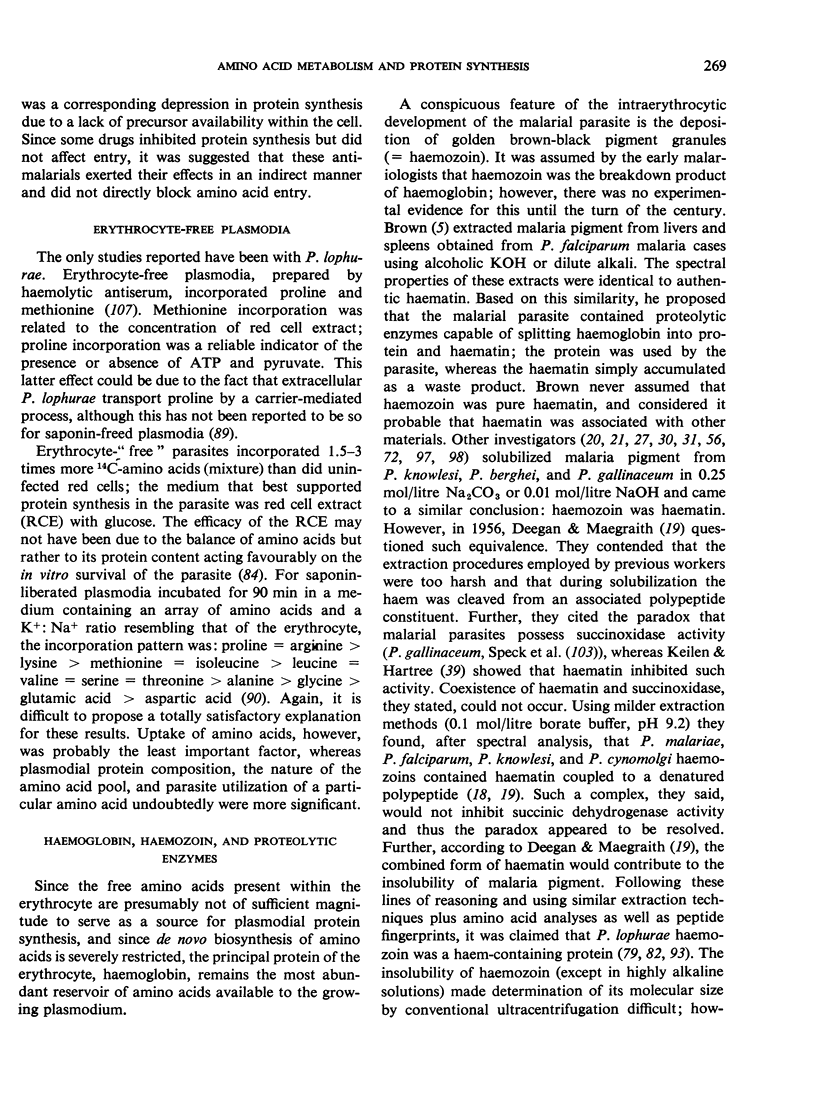
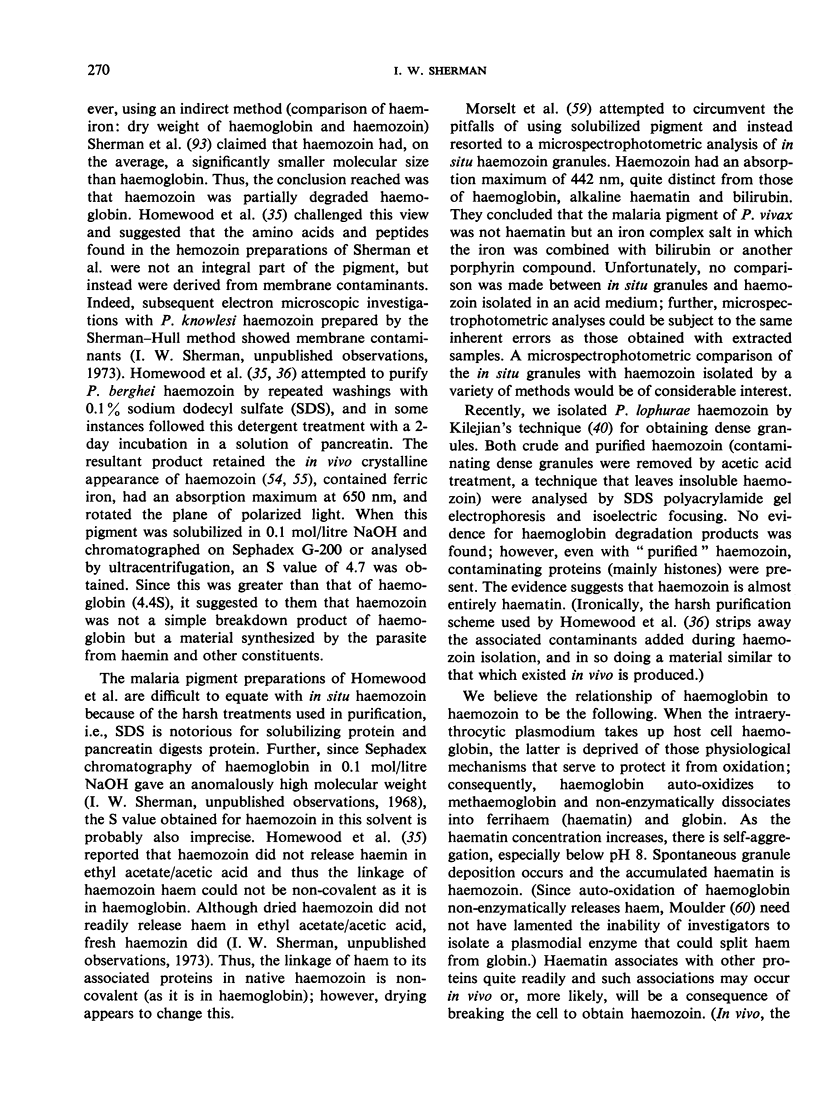
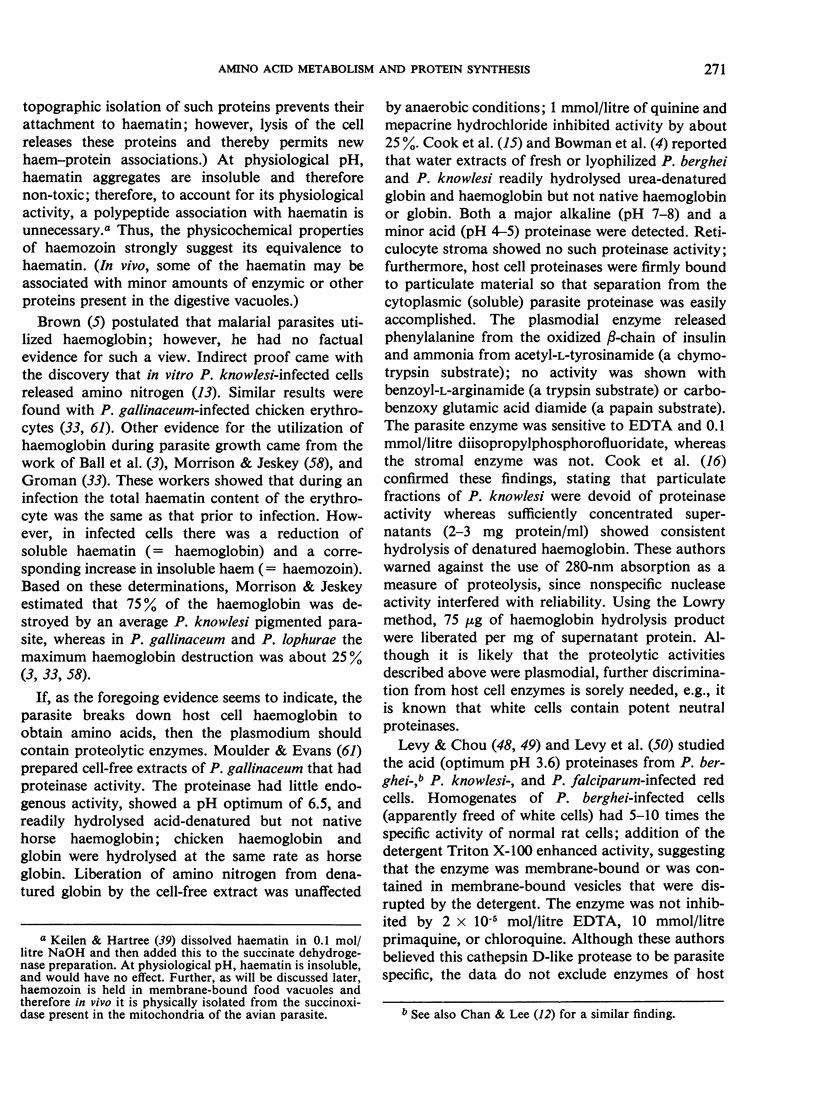

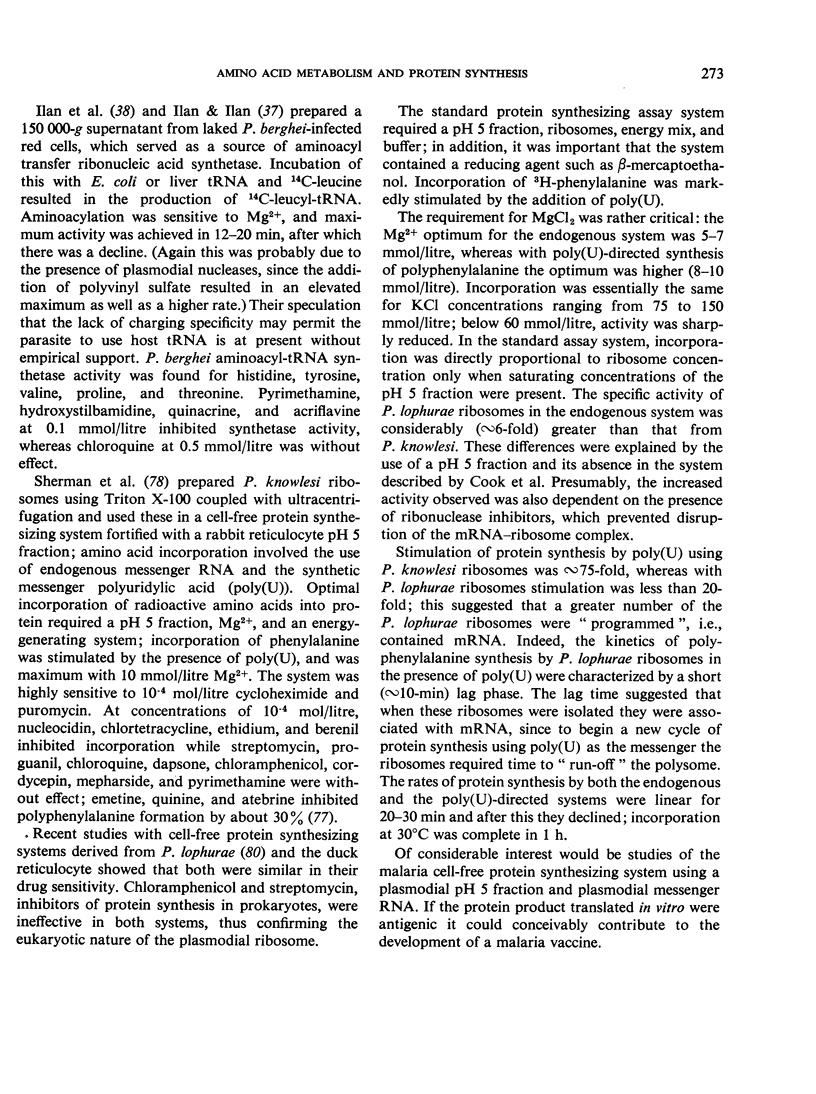
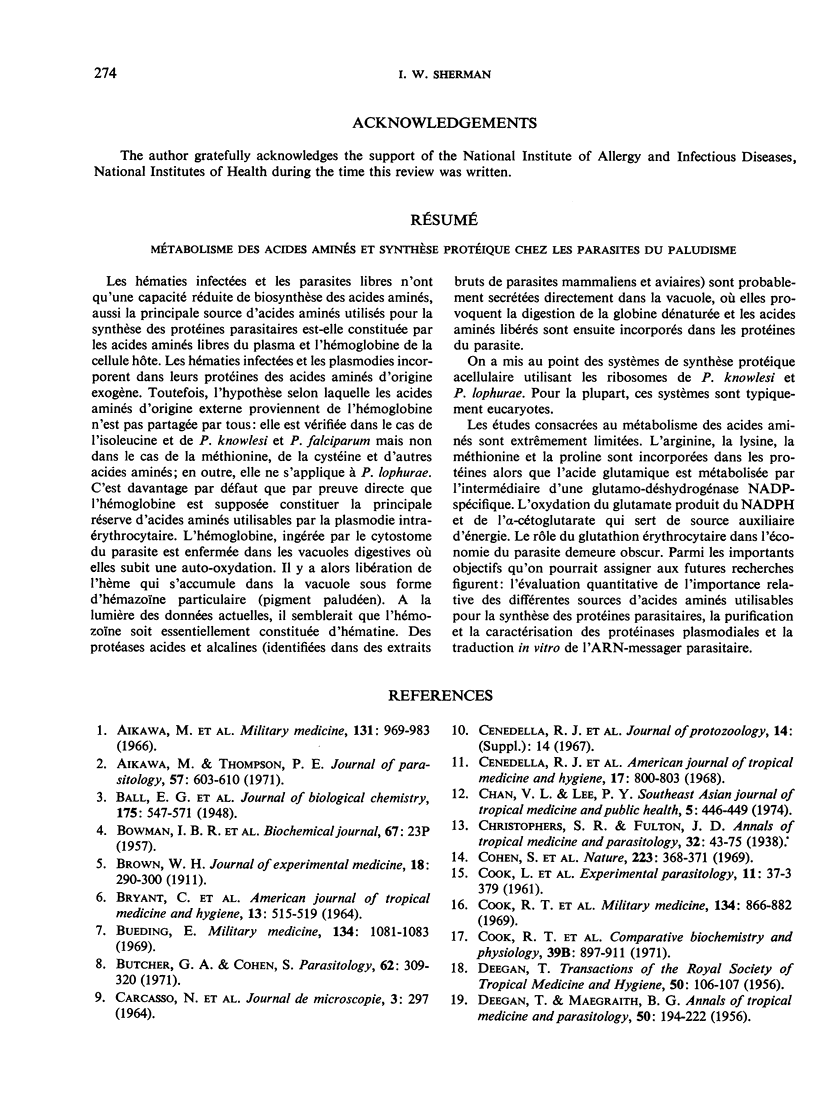
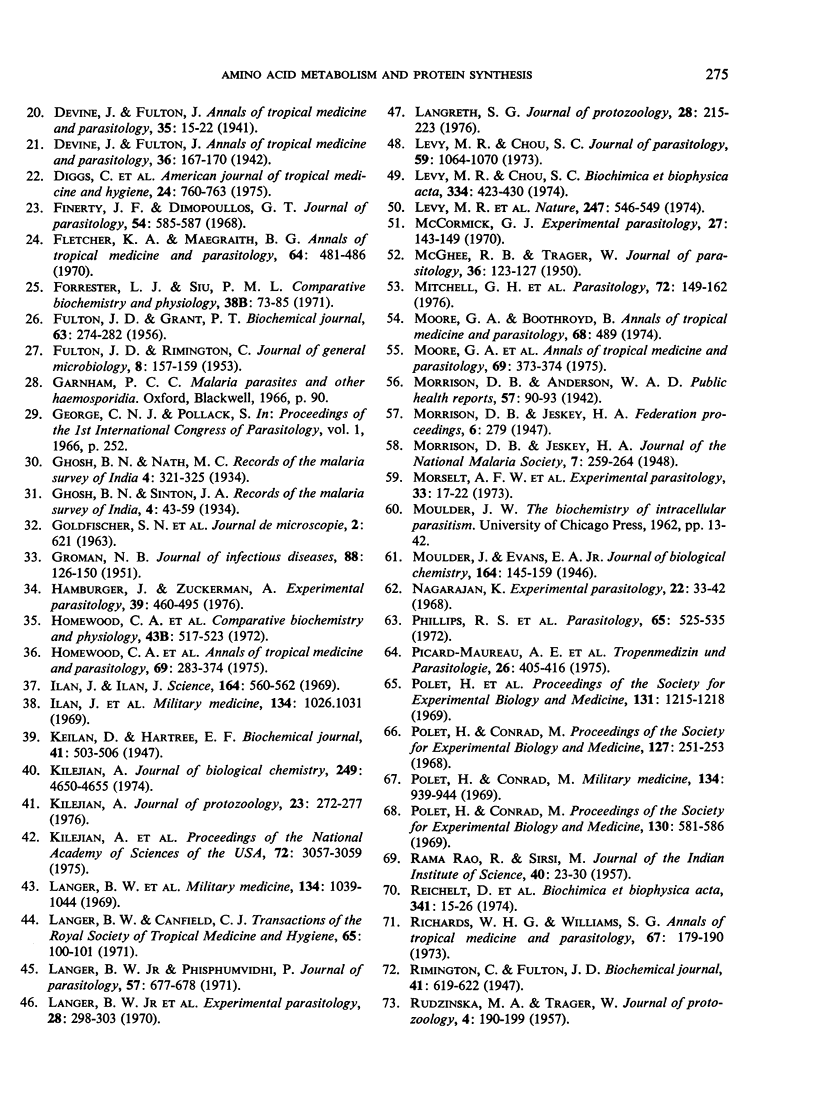
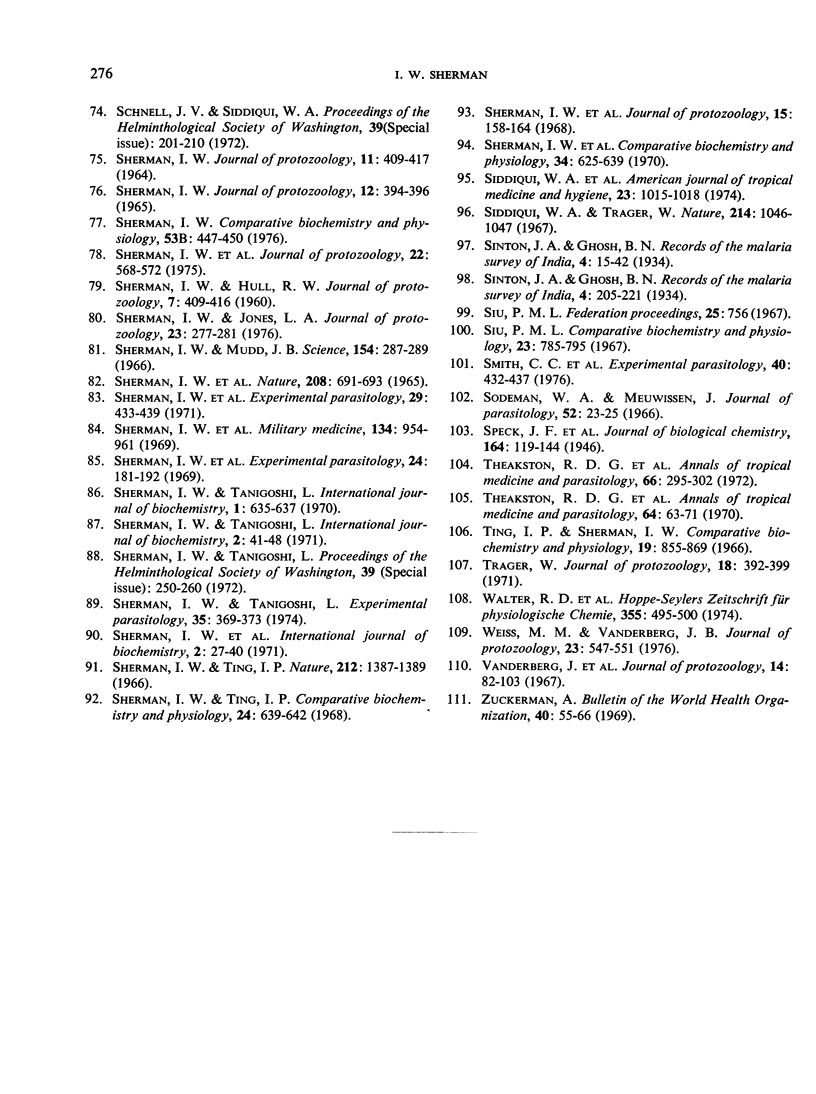
Selected References
These references are in PubMed. This may not be the complete list of references from this article.
- Aikawa M., Thompson P. E. Localization of acid phosphatase activity in Plasmodium berghei and P. gallinaceum: an electron microscopic observation. J Parasitol. 1971 Jun;57(3):603–610. [PubMed] [Google Scholar]
- Butcher G. A., Cohen S. Short-term culture of Plasmodium knowlesi. Parasitology. 1971 Apr;62(2):309–320. doi: 10.1017/s0031182000071547. [DOI] [PubMed] [Google Scholar]
- Chan V. L., Lee P. Y. Host-cell specific proteolytic enzymes in Plasmodium berghei infected erythrocytes. Southeast Asian J Trop Med Public Health. 1974 Sep;5(3):447–449. [PubMed] [Google Scholar]
- Cohen S., Butcher G. A., Crandall R. B. Action of malarial antibody in vitro. Nature. 1969 Jul 26;223(5204):368–371. doi: 10.1038/223368a0. [DOI] [PubMed] [Google Scholar]
- DEEGAN T., MAEGRAITH B. G. Studies on the nature of malarial pigment (haemozoin). II. The pigment of the human species, Plasmodium falciparum and P. malariae. Ann Trop Med Parasitol. 1956 Jun;50(2):212–222. doi: 10.1080/00034983.1956.11685760. [DOI] [PubMed] [Google Scholar]
- FULTON J. D., GRANT P. T. The sulphur requirements of the erythrocytic from of Plasmodium knowlesi. Biochem J. 1956 Jun;63(2):274–282. doi: 10.1042/bj0630274. [DOI] [PMC free article] [PubMed] [Google Scholar]
- FULTON J. D., RIMINGTON C. The pigment of the malaria parasite Plasmodium berghei. J Gen Microbiol. 1953 Feb;8(1):157–159. doi: 10.1099/00221287-8-1-157. [DOI] [PubMed] [Google Scholar]
- Finerty J. F., Dimopoullos G. T. Disk electrophoretic separation of soluble preparations of Plasmodium lophurae and Anaplasma marginale. J Parasitol. 1968 Jun;54(3):585–587. [PubMed] [Google Scholar]
- Fletcher K. A., Maegraith B. G. Erythrocyte reduced glutathione in malaria (Plasmodium berghei and P.knowlesi). Ann Trop Med Parasitol. 1970 Dec;64(4):481–486. doi: 10.1080/00034983.1970.11686719. [DOI] [PubMed] [Google Scholar]
- Hamburger J., Zuckerman A. Plasmodium berghei: I. Immunochemical properties of fractions of a soluble extract. Exp Parasitol. 1976 Jun;39(3):460–478. doi: 10.1016/0014-4894(76)90050-3. [DOI] [PubMed] [Google Scholar]
- Ilan J., Tokuyasu K. Amino acid activation for protein synthesis in Plasmodium berghei. Mil Med. 1969 Sep;134(10):1026–1031. [PubMed] [Google Scholar]
- Kilejian A. Does a histidine-rich protein from Plasmodium lophurae have a function in merozoite penetration? J Protozool. 1976 May;23(2):272–277. doi: 10.1111/j.1550-7408.1976.tb03768.x. [DOI] [PubMed] [Google Scholar]
- Langer B. W., Jr, Phisphumvidhi P., Jiampermpoon D. Malarial parasite metabolism: the glutamic acid dehydrogenase of Plasmodium berghei. Exp Parasitol. 1970 Oct;28(2):298–303. doi: 10.1016/0014-4894(70)90100-1. [DOI] [PubMed] [Google Scholar]
- Langer B. W., Jr, Phisphumvidhi P., Jiampermpoon D., Weidhorn R. P. Malarial parasite metabolism: the metabolism of methionine by Plasmodium berghei. Mil Med. 1969 Sep;134(10):1039–1044. [PubMed] [Google Scholar]
- Langer B. W., Phisphumvidhi P. The amino acid oxidases of Plasmodium berghei. J Parasitol. 1971 Jun;57(3):677–678. [PubMed] [Google Scholar]
- Levy M. R., Chou S. C. Activity and some properties of an acid proteinase from normal and Plasmodium berghei-infected red cells. J Parasitol. 1973 Dec;59(6):1064–1070. [PubMed] [Google Scholar]
- Levy M. R., Siddiqui W. A., Chou S. C. Acid protease activity in Plasmodium falciparum and P. knowlesi and ghosts of their respective host red cells. Nature. 1974 Feb 22;247(5442):546–549. doi: 10.1038/247546a0. [DOI] [PubMed] [Google Scholar]
- MORRISON D. B., JESKEY H. A. Alterations in some constituents of the monkey erythrocyte infected with Plasmodium knowlesi as related to pigment formation. J Natl Malar Soc. 1948 Dec;7(4):259–264. [PubMed] [Google Scholar]
- McCormick G. J. Amino acid transport and incorporation in red blood cells of normal and Plasmodium knowlesi-infected rhesus monkeys. Exp Parasitol. 1970 Feb;27(1):143–149. doi: 10.1016/s0014-4894(70)80018-2. [DOI] [PubMed] [Google Scholar]
- Mitchell G. H., Butcher G. A., Voller A., Cohen S. The effect of human immune IgG on the in vitro development of Plasmodium falciparum. Parasitology. 1976 Apr;72(2):149–162. doi: 10.1017/s0031182000048459. [DOI] [PubMed] [Google Scholar]
- Moore G. A., Boothroyd B. Direct resolution of the lattice planes of malarial pigment. Ann Trop Med Parasitol. 1974 Dec;68(4):489–489. doi: 10.1080/00034983.1974.11686977. [DOI] [PubMed] [Google Scholar]
- Phillips R. S., Trigg P. I., Scott-Finnigan T. J., Bartholomew R. K. Culture of Plasmodium falciparum in vitro: a subculture technique used for demonstrating antiplasmodial activity in serum from some Gambians, resident in an endemic malarious area. Parasitology. 1972 Dec;65(3):525–535. doi: 10.1017/s0031182000044139. [DOI] [PubMed] [Google Scholar]
- Picard-Maureau A., Hempelmann E., Krämmer G., Jackisch R., Jung A. Glutathionstatus in Plasmodium vinckei parasitierten Erythrozyten in Abhängigkeit vom intraerythrozytären Entwicklungsstadium des Parasiten. Tropenmed Parasitol. 1975 Dec;26(4):405–416. [PubMed] [Google Scholar]
- Polet H., Conrad M. E. In vitro studies on the amino acid metabolism of Plasmodium knowlesi and the antiplasmodial effect of the isoleucine antagonists. Mil Med. 1969 Sep;134(10):939–944. [PubMed] [Google Scholar]
- Polet H., Conrad M. E. Malaria: extracellular amino acid requirements for in vitro growth of erythrocytic forms of Plasmodium knowlesi. Proc Soc Exp Biol Med. 1968 Jan;127(1):251–253. doi: 10.3181/00379727-127-32666. [DOI] [PubMed] [Google Scholar]
- Polet H., Conrad M. E. The influence of three analogs of isoleucine on in vitro growth and protein synthesis of erythrocytic forms of Plasmodium knowlesi. Proc Soc Exp Biol Med. 1969 Feb;130(2):581–586. doi: 10.3181/00379727-130-33612. [DOI] [PubMed] [Google Scholar]
- Reichelt D., Jacobsohn E., Haschen R. J. Purification and properties of cathepsin D from human erythrocytes. Biochim Biophys Acta. 1974 Mar 21;341(1):15–26. doi: 10.1016/0005-2744(74)90061-8. [DOI] [PubMed] [Google Scholar]
- Richards W. H., Williams S. G. Malaria studies in vitro. II. The measurement of drug activities using leucocyte-free blood-dilution cultures of Plasmodium berghei and 3H-leucine. Ann Trop Med Parasitol. 1973 Jun;67(2):179–190. [PubMed] [Google Scholar]
- Rimington C., Fulton J. D. The pigment of the malarial parasites Plasmodium knowlesi and Plasmodium gallinaceum. Biochem J. 1947;41(4):619–622. doi: 10.1042/bj0410619. [DOI] [PMC free article] [PubMed] [Google Scholar]
- SHERMAN I. W. ANTIGENS OF PLASMODIUM LOPHURAE. J Protozool. 1964 Aug;11:409–417. doi: 10.1111/j.1550-7408.1964.tb01772.x. [DOI] [PubMed] [Google Scholar]
- Sherman I. W., Cox R. A., Higginson B., McLaren D. J., Williamson J. The ribosomes of the simian malaria, Plasmodium knowlesi. I. Isolation and characterization. J Protozool. 1975 Nov;22(4):568–572. doi: 10.1111/j.1550-7408.1975.tb05235.x. [DOI] [PubMed] [Google Scholar]
- Sherman I. W. Glucose-6-phosphate dehydrogenase and reduced glutathione in malaria-infected erythrocytes (Plasmodium lophurae and P. berghei). J Protozool. 1965 Aug;12(3):394–396. doi: 10.1111/j.1550-7408.1965.tb03231.x. [DOI] [PubMed] [Google Scholar]
- Sherman I. W., Jones L. A. Protein synthesis by a cell-free preparation from the bird malaria, Plasmodium lophurae. J Protozool. 1976 May;23(2):277–281. doi: 10.1111/j.1550-7408.1976.tb03769.x. [DOI] [PubMed] [Google Scholar]
- Sherman I. W., Mudd J. B. Malaria infection (Plasmodium iophurae): changes in free amino acids. Science. 1966 Oct 14;154(3746):287–289. doi: 10.1126/science.154.3746.287. [DOI] [PubMed] [Google Scholar]
- Sherman I. W., Mudd J. B., Trager W. Chloroquine resistance and the nature of malarial pigment. Nature. 1965 Nov 13;208(5011):691–693. doi: 10.1038/208691a0. [DOI] [PubMed] [Google Scholar]
- Sherman I. W., Peterson I., Tanigoshi L., Ting I. P. The glutamate dehydrogenase of Plasmodium lophurae (avian malaria). Exp Parasitol. 1971 Jun;29(3):433–439. doi: 10.1016/0014-4894(71)90052-x. [DOI] [PubMed] [Google Scholar]
- Sherman I. W., Ruble J. A., Tanigoshi L. Incorporation of 14C-amino acids by malaria (Plasmodium lophurae). I. Role of ions and amino acids in the medium. Mil Med. 1969 Sep;134(10):954–961. [PubMed] [Google Scholar]
- Sherman I. W., Tanigoshi L. Incorporation of 14C-amino acids by malarial plasmodia (Plasmodium iophurae). VI. Changes in the kinetic constants of amino acid transport during infection. Exp Parasitol. 1974 Jun;35(3):369–373. doi: 10.1016/0014-4894(74)90042-3. [DOI] [PubMed] [Google Scholar]
- Sherman I. W., Ting I. P. Carbon dioxide fixation in malaria (Plasmodium iophurae). Nature. 1966 Dec 17;212(5068):1387–1388. doi: 10.1038/2121387a0. [DOI] [PubMed] [Google Scholar]
- Sherman I. W., Ting I. P. Carbon dioxide fixation in malaria. II. Plasmodium knowlesi (monkey malaria). Comp Biochem Physiol. 1968 Feb;24(2):639–642. doi: 10.1016/0010-406x(68)91018-9. [DOI] [PubMed] [Google Scholar]
- Sherman I. W., Ting I. P., Ruble J. A. Characterization of the malaria pigment (hemozoin) from the avian malaria parasite Plasmodium lophurae. J Protozool. 1968 Feb;15(1):158–164. doi: 10.1111/j.1550-7408.1968.tb02103.x. [DOI] [PubMed] [Google Scholar]
- Siddiqui W. A., Trager W. Free amino-acids of blood plasma and erythrocytes of normal ducks and ducks infected with malarial parasite, Plasmodium lophurae. Nature. 1967 Jun 3;214(5092):1046–1047. doi: 10.1038/2141046a0. [DOI] [PubMed] [Google Scholar]
- Smith C. C., McCormick G. J., Canfield C. J. Plasmodium knowlesi: in vitro biosynthesis of methionine. Exp Parasitol. 1976 Dec;40(3):432–437. doi: 10.1016/0014-4894(76)90111-9. [DOI] [PubMed] [Google Scholar]
- Sodeman W. A., Jr, Meuwissen H. E. Disk electrophoresis of Plasmodium berghei. J Parasitol. 1966 Feb;52(1):23–25. [PubMed] [Google Scholar]
- Trager W. Malaria parasites (Plasmodium lophurae) developing extracellularly in vitro: incorporation of labeled precursors. J Protozool. 1971 Aug;18(3):392–399. doi: 10.1111/j.1550-7408.1971.tb03341.x. [DOI] [PubMed] [Google Scholar]
- Walter R. D., Nordmeyer J. P., Königk E. NADP-specific glutamate dehydrogenase from Plasmodium chabaudi. Hoppe Seylers Z Physiol Chem. 1974 May;355(5):495–500. doi: 10.1515/bchm2.1974.355.1.495. [DOI] [PubMed] [Google Scholar]
- Weiss M. M., Vanderberg J. P. Studies on Plasmodium ookinetes. 1. Isolation and concentration from mosquito midguts. J Protozool. 1976 Nov;23(4):547–551. doi: 10.1111/j.1550-7408.1976.tb03837.x. [DOI] [PubMed] [Google Scholar]


